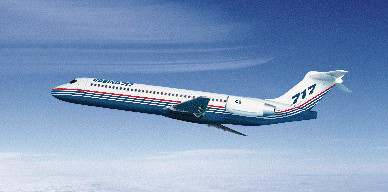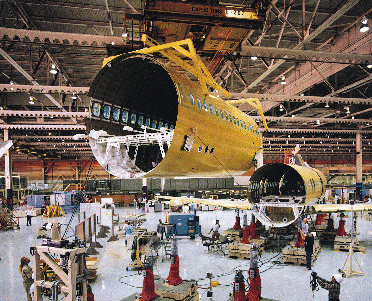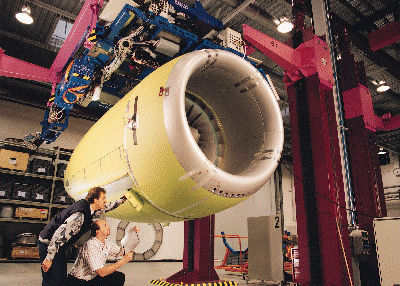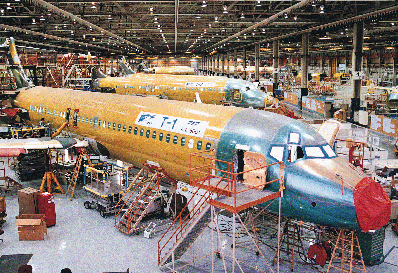
Guy Norris/LONG BEACH
In June a familiar shape is due to take off on a maiden flight from Long Beach, California. Outwardly it will bear the classic hallmarks of a Douglas-built T-tail twinjet, yet in most respects it is a radically new aircraft.
The Boeing 717-200 was once the MD-95. It was renamed in January this year, when the Douglas 100-seater programme was formally adopted into the Boeing line up. The move bolstered the aircraft's future and ended months of uncertainty which had dogged the programme up to, and beyond, the takeover of McDonnell Douglas the previous August.
Boeing's decision to bring the 717 within the fold was influenced by several factors. Well before studies of the shortened A319 were revealed, Airbus Industrie appeared to be moving aggressively in Asia with its proposed AE316/317. This prompted Boeing to view the already developed Douglas twin as more than just an unloved orphan below Boeing's Next Generation 737 series.
Juggling its figures, Boeing estimated that the low cost 717 could provide the key to an untapped 80-120 seat market. It gauged this market to be worth up to 2,500 aircraft over 20 years. Fokker's demise and the cancellation of Aero International (Regional)'s proposed AI(R) 70 Airjet family left Avro's RJ series as the only other significant player in this market. If the small twin could be produced at low cost, it offered Boeing the promise of a genuine 100-seat regional airliner at true regional prices. With most of the programme's estimated $500 million development costs already shared out and paid, Boeing believed that this was too good a chance to miss.
The configuration of the 717 is based strongly on that of the DC-9-30, which first flew in August 1966. The roots of the 717 as a separate aircraft go back to 1983, however. In that year Douglas outlined the DC-9-90, a proposed short body version of the then DC-9-81 (now the MD-81). This aircraft would have seated 117 people and was aimed at the newly deregulated US air transport market.
LAUNCHING THE MD-95
As the world's largest DC-9 operator, Northwest became closely involved with Douglas on the project, which gradually evolved into a firm programme. At the 1991 Paris air show, McDonnell Douglas, Pratt & Whitney and the China National Aero-Technology Import Export agency signed a memorandum of understanding to develop a 105-seat version of the MD-80, for initial delivery in 1995. The MD-87-105 was then renamed the MD-95.
At this early stage, the MD-95 was closely linked to the Chinese TrunkLiner and MD-90 programmes, and was more akin to the DC-9-90 than the DC-9-30. Pratt &Whitney's JT8D-218 and the Rolls-Royce Tay 670 were offered as options, with the first flight pegged for 1994.
In that year, the emphasis shifted back once more to the MD-95, which was now to be powered by the BMW Rolls-Royce BR715, and the aircraft looked more like the DC-9-30. In July 1994, Douglas got MDC board approval to offer the aircraft. It was to be produced at low cost through a unique risk and revenue network of global partnerships. Alenia was selected to build the fuselage, Halla (later Hyundai) of South Korea the wings, Korean Air the nose and British Aerospace the empennage. This work subsequently went to Aero Industry Development Centre of Taiwan.
Douglas also announced that final assembly would take place at Dalfort Aviation's Dallas site in Texas. This work reverted back to Long Beach, however, after a nationwide competition, hard bargaining with the unions and concessions from the California State government. Development costs at the time were estimated at around $500 million, of which some $200 million was down to Douglas.
In March 1995, on the verge of launch, the programme was struck an almost fatal blow when formerly loyal Douglas user SAS selected the 737-600 over the MD-95. Further uncertainty dogged it later that year when P&W's Mid Thrust Family Engine, now the PW6000, re-entered as an option after BMW R-R's exclusive agreement expired without renewal. Things looked bleak until 19 October, 1995, when ValuJet announced 50 orders and 50 options for BR715-powered MD-95s.
The orderbook refused to grow despite the best efforts of the Douglas sales team. New hope came with Boeing's adoption of the twinjet and its renaming as the 717. With roll-out set for May 1998, it seems certain that the sales drought is about to come to an end.

BUILDING ON THE DC-9
"Safe, simple and dependable - those were the three things the DC-9 was based on," says chief project engineer Tom Croslin. "We took the same approach with the 717. From the start, we had very strict rules about what changes and additions we made to the basic design. If it did not reduce recurring costs or improve dispatch reliability or reduce maintenance costs, or affect at least two of these areas, it didn't get on the aircraft."
The biggest structural changes were in the tail area. The use of the larger and heavier BR715 engines required substantial redesign of the empennage, which was based on that of the MD-87. "We modified an MD-80 pylon and adapted it for the BR715 by making it thinner," says Croslin. The revised pylon does not have the larger twinjet's powered flap, introduced to counter deep stall. The pylon design is also simplified by the omission of the pre-cooler, which is engine mounted in the BR715.
The design team also faced the problem of how to accommodate the significantly heavier engines without building a complex strut box support into the tail area. The BR715 weighs in at around 2,930kg including nacelle, compared to 2,120kg for a "straight eight" Pratt & Whitney JT8D-7/9. The solution was to insert an extra frame between the existing aft frames. This extra frame supports only the weight of the engines. The thrust loads are taken by the front mount.
The tail area was also clad in the thicker skin used on the MD-80, to help meet current European Joint Airworthiness Requirements and USFederal Aviation Regulations. In particular, stiffer skin and strengthened hinge points were needed to meet structural requirements in the event of a jammed control surface in addition to an abrupt maximum control input.
The increased engine weight and longer lever arm also required additional static stability. This was achieved by extending the tip cap of the MD-87-style tail by an extra 250mm. To balance the heavier tail, the forward fuselage was stretched by three frames, or 1.45m.
"Originally, we put in two frames, and that balanced," Croslin says. "AirTran wanted another seat row, however, so we added 57in [ 1.45m] in all. This played us right into perfect balance, although we were a little concerned at the time that we might be making the aircraft too big. We didn't want to push ourselves on to the 737."
Some changes were also made to the wing, which, externally, is virtually identical to the wing of the higher gross weight DC-9-34 version. The wing incidence angle was increased by 1.25í to replicate the -34 and to increase maximum take off weight (MTOW) capability to 55,000kg. The wing is otherwise unchanged from the basic -30 series, with an area of 92.97m2, a thickness/chord ratio of 11.6% and a sweepback at quarter chord of 24í.
The design team also introduced drag improvement items originally developed for Swissair's DC-9 fleet and subsequently to the MD-90. These included slat seals between the ribs and at the bottom and top of the slats. "We found a lot of air spilling through on the original wing/fuselage fillet," says Croslin. The redesigned fillet combines with the slat seals to give a drag improvement of around 1% over the DC-9. The revised fillet is extended forward by a further three bays with a composite structure.
"The goal was not to use composites, because the maintenance community hate it," says Croslin. "With composites, you need things like autoclaves for repairs, whereas any farm boy from Minnesota can repair a dent in aluminium with a silver dollar patch."
Composites therefore make up only a few items on the 717. These include the low drag trailing cone, tip cap, tabs on the elevator and aileron, the wing/fuselage fillet, the radome and wing trailing edge panels.
The only major shift in materials is a move from the 2014 aluminium alloy used on the DC-9 to the more modern 2024T3 alloy, which has better damage tolerance and slower crack propagation. "When you're talking about average sectors of 300-500nm [550-900km], trip cost is the most critical factor. That's not going to be driven by 10lb [ 4.5kg] of composites, it's going to be driven by the cost of repair," Croslin says.
Despite their aversion to composites, members of the 717 design team are happy to have a comfortable margin in meeting the nominal (not guaranteed) weight target. As the first aircraft, T-1, comes together in Long Beach, indications are that weight is below nominal by just under 1% of MTOW.
"We controlled weight from day one, whereas a lot of programmes only deal with it when they're in trouble," Croslin says. The margin may be used to increase the number of provisions in the basic aircraft and so reduce the definition time required to outfit each model for different users. The target time is six months.
There are other structural changes. Double "bullwheel" mechanisms protect against inadvertent asymmetric slat deployment. Changes to the main landing gear are based on experience gained from corrosion resistance measures first taken with the MD-90. The gear will also be fitted with all steel brakes, to give the 717 an estimated 1,150 landings per brake, compared to 600 for the DC-9. The long life steel brakes fit onto a set of shear pins, eliminating the multi-bolt design used on the DC-9.
The use of a new in-line 207bar (3,000lb²) engine driven hydraulic pump eliminates the need for the 103bar selection switch on the DC-9. Now that all the hydraulically actuated systems on the 717 operate at 207bar, it has been been possible to remove the maintenance intensive hydraulic step-down pressure reducers fitted on the older aircraft.

POWERFUL ADVANCES
The BMW Rolls-Royce BR715 is one of the major technical advances on the 717 and forms the cornerstone of the aircraft's low performance costs. On 28 April, 1997, the most powerful version of the two-shaft BR700 series ran for the first time. It throttled up to its redline limit of 115kN (25,750lb) during the first phase of testing. In initial service, on the 717-200, the engine will be rated at 82kN.
Mounted on the 717 for the first time in February 1998, the engine is characterised by its large 1.47m-diameter fan. Relative to the five-abreast fuselage, this gives the 717 a similar head-on appearance to the International Aero Engines V2500-powered MD-90. The 24 solid titanium wide chord fan blades are driven by a two-stage high pressure (HP) turbine and 10-stage HP compressor derived from the V2500. The BR715 is also fitted with a two-stage low pressure (LP) compressor and a three-stage LP turbine.
BMW R-R says that initial tests showed performance to be at specification level. "Handling was excellent with smooth accelerations and no speed restrictions." The company adds that "-altitude chamber tests validated specific fuel consumption predictions".
Fortunately for the flight test programme, tests at high altitude conditions also revealed cracking in the third stage HPC blades. New blades were designed to counter the problem, and had been installed in three production engines by March. The first shipset for T-1 was installed unmodified, however, and will be retrofitted later in the flight test programme. "It will have no impact on roll-out, but maybe some impact on first flight," says Croslin. He describes the redesign as a "normal development issue. BMW R-R has done an excellent job of recovering."
The key aspect of the engine from the airline's perspective, however, is ease of maintenance. This was designed in from the start, in response to input from an airline advisory team. So pneumatics are on the top of the engine and fuel and oil at the base. The engine is mounted in a simple, long-duct nacelle that provides easy maintenance access to components located on the fan case. And the hinged lower door is strong enough to support two engineers and their maintenance equipment.
The BR715 is also fitted with an electronic engine control (EEC) to improve engine life and provide automated fault reporting and close monitoring capabilities. The EEC eliminates the need for throttle rigging during engine change. It also allows many components to be changed and verified without the engine run required on the DC-9.
The Sundstrand Auxiliary Power International APS2100 auxiliary power unit (APU) is also fitted with an electronic control unit that monitors and optimises its operation. The APU inlet has been moved from the lower aft section to the upper left side of the aircraft. "This will reduce noise in the ramp area. Our target is 85dB at the service locations," says Croslin.
The 717 is the first programme in which Sundstrand Power Systems has been responsible for more than the APU itself. As well as the APS2100, Sundstrand has designed and is responsible for certificating the inlet duct, inlet door, exhaust duct and support frame assembly. The integrated assembly was also subject to the most stringent "conformity inspection" requirements ever met by Sundstrand. These include cold soak tests with repeated starts at -53ºC, severe acoustic validation and electromagnetic interference tests.
The first two flight test APUs have now been delivered. They differ externally from the standard APS2000 family in having a redesigned inlet plenum and bleed valve locations.

AVIONICS AND FLIGHT CONTROLS
Like the aircraft itself, the 717 flightdeck is a synthesis of Boeing and Douglas technology. Modelled largely around the display format pioneered on the MD-11, the flightdeck also uses liquid crystal displays (LCDs) of the type originally used on the 777. Similarly, the aircraft's versatile integrated avionics (VIA) computers are based largely on technology which Honeywell developed for the 777 and repackaged and enhanced for projects like the MD-10 conversion programme.
The uncluttered flightdeck is dominated by six 200x200mm flat panel LCD screens made by Honeywell. These present all essential flight, navigation, engine and systems data. The integrated flightcrew warning and alerting system replaces the electronic overhead annunciator panel, dedicated warning lights, gauges and other system status lights. The remaining overhead panel switches are grouped by aircraft system, and are divided according to left, right and auxiliary systems.
The LCDs also show up to 10 selectable synoptic displays covering hydraulic, environmental, electrical, fuel, aircraft configuration and engine systems. These provide data on system status, failures, operating modes and configuration.
The VIA computers form the heart of the 717's state of the art flightdeck. They process data for display on the LCDs and function as the flight management system (FMS), central aural warning system and flight data acquisition system. To ensure the 717's compatibility with the opens skies environment of the 21st century, the dual FMS can also support a global positioning system, future air navigation systems and a pilot/controller datalink. "It's similar in operation to the MD-90, and we're doing a trade study to see what features it should have to bring it closer to the Boeing family," says Croslin.
Separate flight control computers give the 717 full Category IIIa automatic landing capability. Boeing says that Cat IIIb will be provided with the addition of a radio altimeter, instrument landing system receiver and inertial reference unit (IRU). During the early development phase, a hybrid Cat IIIb capability using a head-up display system was considered. This was rejected in favour of the current arrangement, however, and Boeing says that it has no plans to review the issue.
Another advance is the air data inertial reference unit (ADIRU), which combines the functions of the air data system and IRU. The ADIRUs receive digital pitot and static pressure data from air data modules. The design places these modules adjacent to the pitot tubes and static ports to reduce the amount of tubing and eliminate the need for leak checks following replacement.
Although the basic cable driven primary flight control system of the DC-9 is unchanged in the 717, some improvements have been made to the newly styled pedestal, which incorporates removable control modules. "It's a cast unit, rather than a built up unit. The old design was a watchmaker's dream, but a maintenance headache," says Croslin.
Any pilot familiar with the DC-9 cockpit will immediately notice the absence of the horizontal stabiliser "suitcase handles", the outflow valve manual control wheel, crossfeed levers and trim control knobs. "A new electric rudder and elevator trim control system has eliminated the manual aileron and rudder trim knobs, as well as the cables that ran all the way from the pedestal to the tail," Croslin says. A new electrically controlled spoiler system with a vernier control handle allows the crew to set the speed brakes at any position - from zero to full deployment - without the need for detents or latches.
NEW SYSTEMS
Like so many aspects of the 717, the systems are designed to be inherently trouble free and easy to maintain. The primary electrical system, for example, consists of three identical power conversion and distribution units (PCDUs). These perform the functions formerly provided by a generator control unit in conjunction with the transformer rectifier and bus tie relays. "All three are exactly the same and effectively give us a 'hot' spare," says Croslin. "Two are OK for dispatch on the minimum equipment list, which is ideal if you have a problem and you're out in the middle of nowhere."
The system consists of two engine-mounted 35/40kVA integrated drive generators and a 60 kVA APU generator. Each generator is controlled by a PCDU. The primary electrical relays are modular and mounted to the front of the PCDU for easy replacement. Since repair and troubleshooting were a design priority throughout, the system is made up of modular plug-in relays instead of bolt-in canister relays. "We've probably eliminated 90% of the canister relays," confirms Croslin. Similar improvements include the use of modular bussed connectors instead of entire "mod" blocks, and pressure feed-through connectors instead of the notorious "gummed-up" potted pressure feed-throughs of old.
Although the fuel system is based on the DC-9, it has been improved by a more reliable capacitance type quantity gauging system and the addition of pressure sensors on each pump. Optional auxiliary tanks have been designed for installation during an overnight shift. Standard fuel capacity is 13,890litres, and can be increased with optional tanks ranging from 1,740 to 4,880 litres in size.
The pneumatic and ice protection system is also much simpler, thanks to the use of a single isolation valve instead of a dual crossfeeds. This allows full time, simultaneous anti-icing of the wing and horizontal stabiliser leading edges. "Rather than having alternating protection on the surfaces we've made two significant improvements," Croslin says. "Under the old design we had shared flow, in which we would bleed air for 15 minutes on the wings and 2.5 minutes on the tail. Now with this split system we get simultaneous protection. We believed the regulations were moving towards more stringent requirements, particularly with it being a T-tail design."
A pneumatic overheat detection system (PODS) provides a back-up to the single valve system that eliminates the tail and wind de-icing timers and relays. To improve PODS dispatch reliability, dual loop sensors replace the bimetallic point sensors used on the previous design. If a leak or burst is detected, the affected part of the system is automatically shut off. As part of the overall system changes the "piccolo tube" distributing bleed air to the leading edge of the stabiliser has been extended to the tips.
The improved air conditioning system produces a substantial weight saving. Developed by AlliedSignal, the system incorporates a "three-wheel" air conditioning pack.
"The connecting shaft between the AC unit's existing two wheels has been extended to run a third wheel," says Croslin. "This means the same power is used to pull exterior air over the heat exchanger, so the need for a dedicated electrical system for a cooling fan is now eliminated. It's a much simpler design, inexpensive and easier to maintain."
NEW LOOK CABIN
Pressure to the cabin is controlled through a single, electrically controlled outflow valve similar in design to that used on the 767. This eliminates the manual pressurisation wheel from the flight deck pedestal and all associated cable runs throughout the aircraft. The crew can select manual mode by pressing a button on the overhead panel and using a three-position toggle switch to control pressurisation.
The cabin itself retains the familiar five-abreast economy layout of all Douglas twins, but is otherwise very different in overall appearance. Crafted by Fischer, the Austrian cabin design specialists, the interior has improved lighting, larger overhead storage bins, new three-bay sidewall panels and modular lavatories with a vacuum waste system.
The lighting system uses solid state, flicker-free ballasts with selectable cabin illumination levels. The three-bay sidewall panels enable maintenance crews to access the inner and outer window panels and window shade areas without removing sidewalls or seats. Croslin says: "You'll only need a Phillips screwdriver to get them off, and no tools at all are needed to remove the ceiling panels".
The stowage bins are bigger than on the DC-9, and even larger asymmetric compartments are offered as an option. The full-grip handrail, successfully introduced on the MD-90, runs the length of the cabin.
FAMILY PLAN
Boeing's family plan for the 717-200 includes two sisters, a shorter -100X and a longer -300X, both derived from the original MD-95-20 and -50 studies. The -100X would extend the family to cover the 75-80 seat market, and the -300X would cover the 125-130 seat market.
The BR715 would power all versions. Croslin says the BR710 was studied for the -100X but "for commonality reasons we determined we were better off to stay with the 715 to keep the costs of design changes to a minimum".
Studies continue, but the latest concepts include a four frame reduction for the -100X to give an overall length of around 35.9m compared to the -200's 37.8m. The -300X, on the other hand, could be stretched by up to five frames to an overall length of around 40.2m.This shrink and stretch policy is easier to adopt since Douglas moved from the clamshell production method of the DC-9/MD-80 to a barrel assembly method with the MD-90. The existing forward barrel would be retained for the -300X.
While the auxiliary tanks are available as an option, Boeing says it is not "marketing a -200ER version per se, because we want to focus on marketing for the 300-500nm sectors, and we're trying to keep it distinct from the 737 marketing efforts".

WHATS IN A NAME ?
Boeing's decision to rename the MD-95 as the 717 marked the end of a line extending back more than 65 years to the first delivery of the DC-1 in 1933. The Douglas Commercial (DC) family changed nomenclature to the MD (McDonnell Douglas) line with the MD-80 series in the late 1970s, although the series was certificated as the DC-9-80. The Model 717 designation was originally given to the military KC-135 series for the US Air Force, with the first production batch ordered as 717-100As. The designation was later briefly considered for the 720, which was first called the 707-020 and then the 717-020, before finally reverting to 720-020. Boeing says that the 1 in the 717 refers to the "100-seater" capacity of the aircraft.Source: Flight International
















